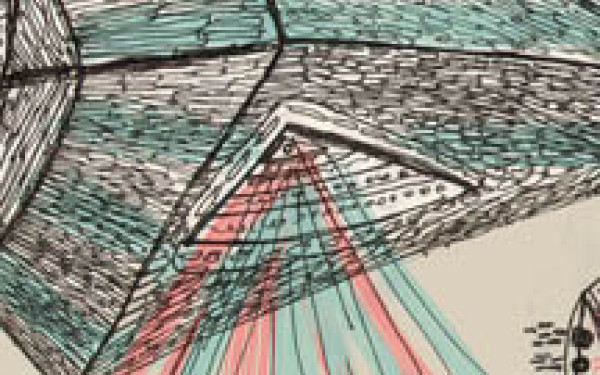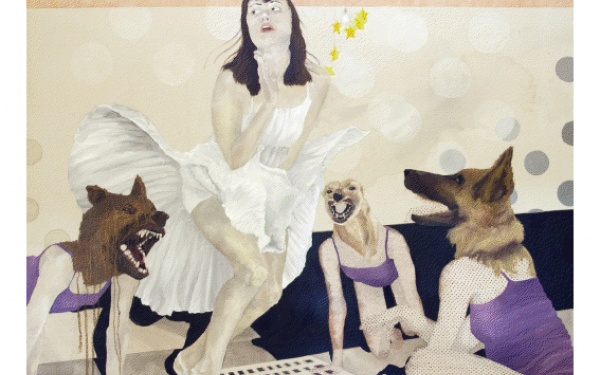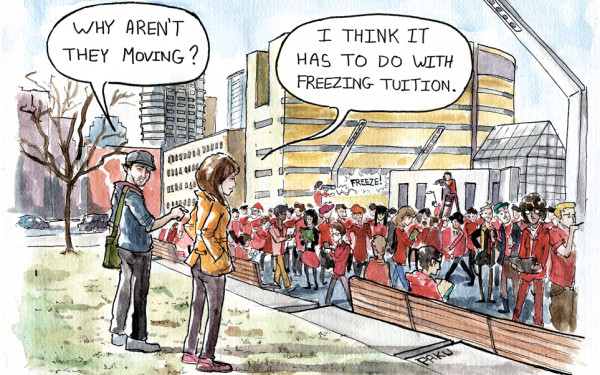Exploring the Darkness
Chronicles of a Disappearance Digs at Our Deepest Fears
We are often perched just at the edge of a void—going through life with an unrealized deep-rooted fear of death, the unknown and the unfamiliar.
Chronicles of a Disappearance, on now at the DHC/ART Gallery, is the kind of exhibit that leaves you thinking about these things for days afterwards.
Bringing together five international artists, it showcases a variety of mediums including video, photography, installation and projection. Incorporating history, politics and a critique on social norms, the exhibit explores feelings of loss, absence and mourning, as well as the obscure, the odd and the inaccessible.
In other words, it bluntly brings us into the darkness of our world—the things that aren’t immediately visible or that we often try to ignore.
DHC is divided into two separate buildings. On one side, the gallery is tall, and part of the process is climbing a multitude of stairs to get to each separate piece.
The upward momentum adds to the impact of the exhibits, especially in this case, as you feel like you’re travelling to different locations, and the time spent climbing allows you to process. The second building is split into two equal spaces.
The first artist is Taryn Simon, whose installation An American Index of the Hidden and Unfamiliar is a series of photographs that takes up two floors.
The first level deals with images of oddity, deformity and death. She displays the kinds of weird realities that we are not granted access to as the public. The photographs are sparse and portrait style, with the ideas behind them not becoming obvious until the viewer reads the annotation displayed beside.
The second floor is a startlingly complete picture of American greed-farms where you can pay to hunt an almost-extinct animal for fun, piles of money, and mounds of rotting food confiscated at John F. Kennedy airport. It paints a dark picture of the American underbelly—crime, greed, excess and indulgence.
Cuban artist Jose Toirac’s single-screen projection, Opus, features the voice of Fidel Castro in a speech that Toirac edited down to just numerical statements.
As Castro states them, the numbers appear in white on a black screen. The audio echoes around the room, and the sequence of numbers feels empty and mechanical, a strange imprint of a dictator slowly disappearing from the public focus.
Omer Fast’s 30-minute video, 5000 Feet Is the Best is a juxtaposition of American video-game culture and the post-traumatic stress disorder associated with actual drone aerial vehicle operators. The film blends fact, fiction and the creator’s own fantasy into a complicated and inter-woven narrative.
Teresa Margolles’ Plancha is perhaps the most subtly haunting piece in the exhibit. It’s an installation composed of 10 heated steel plates in a row, with water dripping down periodically onto each, steaming and evaporating into the room.
The water is sourced from a morgue in Mexico City where the artist worked, where it was used to clean corpses after autopsy. When the water hits the steel plates and is evaporated it mists throughout the room—confronting our fears of contamination and contact with the dead.
Standing in the room is unsettling, but if you hadn’t known where the water was coming from you might feel differently—the marks it leaves on the plates form a beautiful pattern, an unassuming minimalist sculpture.
Finally, Phillip Parreno’s June 8, 1968 is a reenactment of the train ride that brought Robert Kennedy’s corpse from New York to Washington.
Filmed landscape-style and shown on a wall-sized screen in a white room with red carpet, the audience is made to feel like they are on the train, watching the cities and people pass.
There is a deeply creepy beauty to the film, with the moving landscape interacting with the motionless people watching the train pass. When the lights reappear, you realize you’re standing in a room eerily reminiscent of either the White House, or a funeral home—or maybe a cross between the two.
Each individual artist showcases pieces that have a soft, haunting beauty. Displayed on and in the white, neutral backdrop of the DHC/ART gallery spaces, the pieces are sparse and affecting.
The message behind the exhibit is strongly political, and it produces a great platform for dialogue.
The five artists each bring a different element, or culture, to the table—but the discussions and the mediums interact with each other on a larger scale. The exhibit grants access to unconscious fear, remembers traumatic events, uncovers the hidden and asks direct questions about the state of our society.
By granting us direct access to our fears and to the dark void that is death and absence in the world, Chronicles of a Disappearance allows us to step out into a bit of light.
Chronicles of a Disappearance / Jan. 19 to May 13 / DHC/ART (451 & 465 St. Jean St.) / Free admission / dhc-art.org

21_900_675_90.jpg)
_600_832_s.png)


1_600_375_90_s_c1.jpg)

